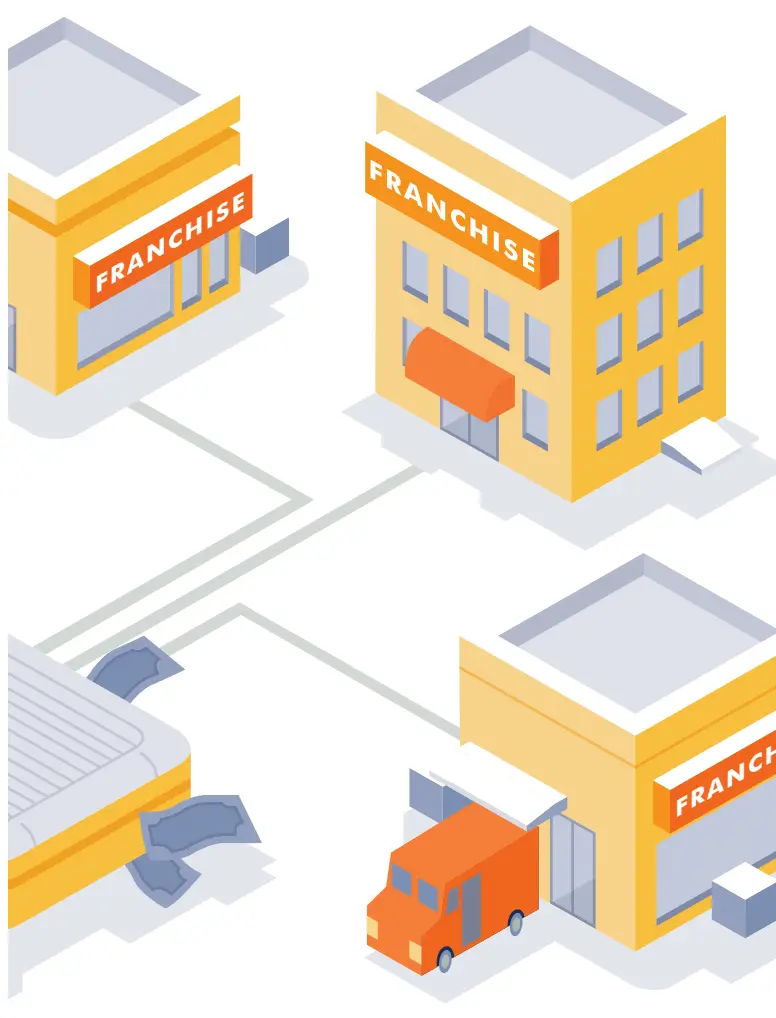The franchise business is booming. Since the downturn nearly a decade ago, the number of franchise locations has been expanding at a healthy rate.
While this is good news for established franchises, this expansion has increased competition in attracting the right franchisees, who in turn are facing stiff competition for good employees.

“In the fast-food industry alone, annual turnover is at a record 150% according to the Oracle division PeopleSoft. That means a restaurant with 20 jobs has to hire an average of 30 people a year to fill them.” JON MARCUS, ENTREPRENEUR
An Appealing Business Model
For entrepreneurs who want to rapidly expand their successful business, franchising is an effective strategy. And for entrepreneurial-minded people looking to buy a business with a market-tested product and a proven business plan, becoming a franchisee is an attractive option.
This model rewards initiative reinforces the strength of the brand and can offer an unlimited return on the initial investment.
When things go well.
Like any business, franchises operate at a risk. Just because the last 20 locations have been profitable, there’s no guarantee the newest location will succeed. And in fact, entire franchises (including category leaders) can fail.

Successful operation and expansion rely on many moving parts, including the franchisee buying into the franchisor’s philosophy, the franchisor providing leadership for mutual benefit, and adequate capitalization to weather the unpredictable marketplace.
How could this fail?
In 1992 Gary and Diane Heavin opened a fitness center that was to become one of the fastest growing franchises ever in the U.S. It solved a huge problem for women who wanted to get in shape, lose weight, and didn’t want to exercise in front of a bunch of sweaty men.
They called it Curves.
Less than 7 years after selling its first franchise, the company exploded to nearly 7,000 locations. (For comparison, it took iconic Gold’s Gym more than 50 years to grow to 700 locations.) Curves franchisees were profitable and many more were opening multiple locations. It seemed like there could be no limit to the expansion.
“Only 15% of Americans go to the gym,”
said founder Gary Heavin.
“We have a huge untapped market.”
But within two years of its peak, the expansion had turned into a contraction and the company found itself in free fall. Over the next five years, wave after wave of club closures left Curves with just half the number of locations compared to its peak.
What went wrong?
Sometimes, it’s difficult to identify the exact reasons for a franchise’s failure. However, in the case of Curves, several major factors clearly played a part: the economy, over-saturation, and changes in women’s workout habits. But according to Heavin, there was another major cause of the contraction—franchisees who were more interested in making money than in embodying the Curves philosophy.

He points out that these were second-generation owners who purchased their fitness centers from original franchisees and then ran them as cheaply as possible. Heavin said the original owners were carefully screened, but corporate headquarters had no say over who they sold their locations to.
The franchisees, in turn, complained that headquarters largely ignored their requests for operational flexibility. Curves locations were not allowed to open up the gym for unsupervised workouts—something the franchisees said was causing customers to go elsewhere.
While a franchise needs many things to go right in order to succeed and grow, the Curves story demonstrates that two of the most important are the quality of the franchisees and the leadership of the franchisor.

A company that wants to franchise successfully must have an innovative idea and a unique brand image. This is simply table stakes for being considered as an investment by serious, would-be franchisees.
For a franchise to expand in the current, highly competitive retail environment it must do much more than make a great first impression. It must have a unique take on whatever product or service it’s selling. One that is believed and embodied by each franchisee, so that each new location conveys the specialness of the original store. Not every would-be franchisee can pull this off.
Lori Joyce, co-founder of the Cupcakes by Heather and Lori franchise discovered that finding the right people to open new stores was a challenge. “Everyone can do a good interview,” says Joyce. “They know what I want to hear. We have six weeks of training, but they behave completely differently once they’re in their environment, so it’s really tricky, and as a result, my training really heavily emphasizes cultural fit.”
Additionally, the franchisor must provide the kind of leadership that enables their franchisees to go from good to great.
“When your franchisees don’t know how to solve problems, they will revert to the old way of doing things—many times that is to beat up on the franchisor. Why? Because they are struggling and they thought it would be easier! Build up their toolbox with tools specific to your system. Show your franchisees how the system comes with everything they need and teach them to use those tools to fix the problems.”BOB PHIBBS, RETAIL CONSULTANT AND FRANCHISOR
Like No Other Gym You Can Join
The same year that the Heavins opened their first Curves in Texas, two brothers 1,800 miles away were opening their first fitness location, which would also become an iconic franchise.
Michael and Marc Grondahl purchased a struggling New Hampshire gym and in order to attract members away from better known competitors slashed fees to just $10 a month.
The strategy worked and Planet Fitness was born. In a short while the brothers figured out that they shouldn’t even try to compete with the other gyms. They realized that while most health clubs were vying for the relatively small pool of serious fitness buffs, this left a much larger customer base that no one was pursuing—people who weren’t workout fanatics.
So they removed the heaviest weights and other big equipment, canceled fitness classes, and instigated rules against kinds of obnoxious behavior non-body builders find irritating.

“Planet Fitness has a wide lane to run in,” says Cowen investment analyst Oliver Chen. “Their biggest competition are the movies and the couch.”
But unlike Curves, Planet Fitness didn’t rush into franchising. The Grondahls waited until 2003 to open their first franchisee-owned store, eleven years after the chain was founded. It’s now grown to nearly 1,900 locations on a trajectory that has persisted despite the ups and downs of the economy.
To ensure this consistency, company leadership has been selective about who can become a franchisee, choosing entrepreneurs who are committed to Planet Fitness core values, and are looking to invest long-term.
According to Shane McGuiness, who along with business partner Eric Dore bought the chain’s first franchise, they weren’t just handed the keys to the store.
“The retailers themselves want us next to them. (Shopping centers) are downsizing and putting us next to them to drive traffic. We are taking larger sites for cheaper rates, we are getting the A-plus sites. We are getting the cream of the crop.” CHRIS RONDEAU, CEO PLANET FITNESS
In a saturated industry, we were able to learn and apply the founders’ customer driven approach and key success factors that made the business unique,” says McGuiness. “We quickly understood that it wasn’t just about the affordable pricing that drives this franchise model. These guys had created a complete model with sustainable competitive advantage.”
Rather than focusing solely on growth, Planet Fitness has committed to providing strategic value for their franchisees. For example, in addition to giving a franchisee a blueprint for success, the company uses data and expertise to determine the optimal location for each new club.
Harder and easier to attract the right franchisees
In the past, the franchisors could be the gatekeepers when it came to information available to their potential franchisees. Unless an interested investor wanted to call dozens of existing franchisees to hear how they were being treated, they had to rely on the franchisor’s marketing materials and what they read in the trade publications.
The tables have turned. Now in addition to looking at the financials for a franchise location, an investor has access to the opinions and experiences of dozens or even hundreds of current franchisees. The franchisor may make a sandwich customers will stand in line for, but if they treat their franchisees poorly, would-be investors will be wise to look elsewhere for their next franchise.
The Keys to attracting the right franchisees are simple:

A company with these attributes will ultimately stand out in the crowded field of franchising. And instead of being forced to accept any franchisee with cash-in-hand, will be able to choose the ones who will best embody the heart and soul of their original location.
“ There are so many upsides to having a franchise partner than having a corporate setup, but with comes a more intensive relationship. It’s not a relationship between a VP and an operations manager, it’s a partnership. It’s a much more difficult relationship, but it bears much more fruit when managed well.” ERIK CHURCH
COO OF O2E BRANDS
WHICH INCLUDES
1-800-GOT-JUNK?, YOU MOVE ME,
AND WOW 1 DAY PAINTING
Summary
Franchising is booming, but attracting the right franchisees has never been more challenging—or more feasible. Success relies on selecting franchisees who embody the brand philosophy, providing leadership and tools to help them thrive, and offering a business model that balances growth potential with sustainable operations. Case studies like Curves and Planet Fitness demonstrate that careful franchisee selection, strong franchisor support, and strategic growth plans are critical to long-term success.
Key Takeaways
- Franchise growth has intensified competition for quality franchisees and employees.
- Attractive business models, proven systems, and clear value propositions draw serious franchise investors.
- Franchise success depends on both franchisee quality and franchisor leadership.
- Curves’ contraction shows how misaligned franchisees and insufficient oversight can harm growth.
- Planet Fitness demonstrates the importance of strategic franchisee selection, deliberate growth, and alignment with core values.
- Modern potential franchisees have access to online reviews and experiences, making transparency and brand reputation crucial.
- Keys to attracting the right franchisees: a unique, sustainable concept, strong brand culture, supportive franchisor tools, and careful selection based on cultural fit and long-term commitment.
Frequently Asked Questions
Q. Why is attracting the right franchisees challenging today?
A. Competition is high for both franchisees and quality employees, and potential investors have more access to reviews and information, making them selective about which franchises to join.
Q. What lessons does the Curves franchise case teach?
A. Franchisee quality and alignment with the brand philosophy are critical; ignoring these can lead to over-expansion, operational inconsistency, and brand contraction.
Q. How did Planet Fitness succeed where others struggled?
A. By delaying franchising until the business model was perfected, carefully selecting franchisees aligned with core values, providing strategic support, and targeting a broad underserved market segment.
Q. What role does franchisor leadership play in franchise success?
A. Strong leadership equips franchisees with the tools, guidance, and culture needed to operate successfully and maintain brand consistency across locations.
Q. What are the keys to attracting the right franchisees?
A. A unique and sustainable concept, strong brand culture, effective franchisor support, and careful selection based on cultural fit and commitment to the brand’s long-term vision.
